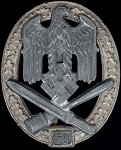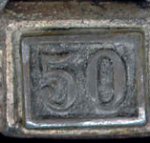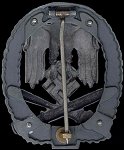
by Sebastián J. Bianchi
General von Brauchitsch instituted the General Assault Badge on January 1st, 1940. The badge, designed by the firm of Ernst Peekhaus of Berlin, was to be awarded to those German soldiers who participated in infantry attacks but were not part of infantry units and therefore did not quality for the Infantry Assault Badge
Manufacturing and Technical Information
The General Assault Badge consisted of an oval disk that measured 53mm by 42mm and was 6mm wide. The disk had raised edges and fine pebbling in the background, with and wreath of oak leaves made of 5 parts laid on each side. This oak leave wreath begins at two acorns located at the base of the badge. The protruding stick grenade and bayonet separate the first two wreaths, while acorns fill the last two separations. The center feature consists of a Wehrmacht Eagle clutching a swastika in its talons. The eagle surmounts a crossed bayonet and a stick grenade, which as mentioned above protruded into the oval disk.
The reverse may either be solid or hollow, with a pin and catch serving as the devise that held the badge to the uniform.
As with most badges the quality of detail in the General Assault Badge is mostly standard, but the quality of materials was not always the same and as a result some of the badges have lost their finish with the passing of time, yielding a gray appearance. For more information on the construction of the General Assault Badge please see the Badge Construction Technique page.
Solid back General Assault Badge (click on images to enlarge)
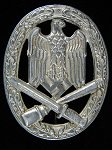 |
 |
S. Bianchi Collection |
|
Hollow back General Assault Badge with envelope from the Mark Schroeder collection. Note that the reverse of the envelope reads "The Manufacturer is responsible for the quality of this decoration and is under control of the Prasidialkanzlei. The manufacturer is obligated to exchange this item if it is found defective"
| Click on images to enlarge | ||
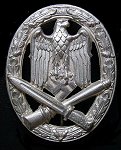 |
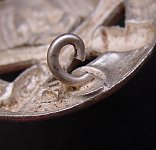 |
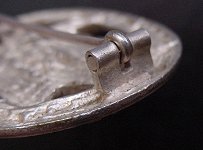 |
 |
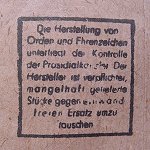 |
|
Presentation, Wear, Documents
The award was most often presented in plain paper packets, that varied in colors, with the name of the award printed on the outside, or in a simple cellophane packet.
As with most badges, the General Assault Badge was worn on the left breast pocket of the tunic as p.The badge was presented with an award document that had the details of the recipient, but no official mention of the deed that earned the award.
Award Criteria
The General Assault badge was presented to engineers (who it was originally designed for), as well as members of the artillery, anti-tank, and anti-aircraft units that served along with the infantry in the conduct of an assault. Also eligible were medical personnel who treated battlefield wounded. In addition, the badge was presented for the single-handed destruction of eight tanks or armored vehicles until the institution (in March of 1942) of The Special Badge for Single Handed Destruction of a Tank. Specific criteria was as follows,
|
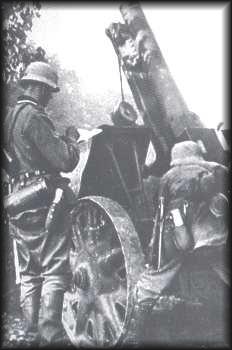 |
General Assault Badge 25, 50 Class


As the war went on, the high command recognized the need for a higher grade of this decoration to be presented to the increasing number of seasoned veterans, and on June 6th 1943, four new grades were introduced. The badge would now be presented to veterans in 25, 50, 75 and 100 classes. The first two are rare but attainable, meaning that they come for sale at regular dealers from time to time, while the latter two are rare in the extreme.
The 25 and 50 badge were similar in style, design and construction. They consisted of an oval wreath of oak leaves similar to the unnumbered badge but larger, measuring 58mm by 48mm with a width of 7mm. At the base of the oval is a box, measuring 10mm by 8mm, with another box measuring 8mm by 6 mm inside of it. In the smaller box was the Arabic number “25” or “50”, depending of course on the grade. The central design was blackened, while the wreath was silvered.
The central motive was again the eagle clutching a swastika on its talons, surmounting a crossed grenade and bayonet. This center design has a black oxidized finish, and was from a different striking which was held on the oval by way of four ball rivets.
Ivan Bombardieri Collection
General Assault Badge 75, 100 Class
These badges were slightly different than the ones described above.In this case, the oak leaves wreaths constituted the inner and outer edge of the oval that measured 56mm by 49mm, and was 7.5mm in width. The box at the base of the circle measured 10mm by 8mm, but the inner box measured 9mm by 7mm, a slight difference.Inside the box were the numbers “75” or “100”, depending on the grade.
The central design was the familiar eagle clutching the swastika surmounting the bayonet and grenade. In this case the eagle is slightly larger, and the bayonet and grenade are crossed at a different angle. The central design was blackened, while the wreath was in this case gilded. The eagle and bayonet/grenade are secured onto the oval by four rivets.
Click on images to enlarge

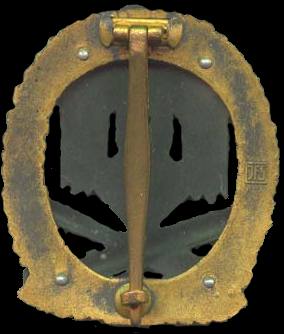
Award Criteria
The numbered awards had the same criteria as the single badge, and was presented in progressive order as the veterans gained more experience. There was retrospective credit given for service in Russia accumulated as follows,
-
Eight months service equaled 10 actions.
-
Twelve months service equaled 15 actions.
-
Fifteen months service equaled 25 actions.
![]()
© Copyright Wehrmacht-Awards.com LLC |

